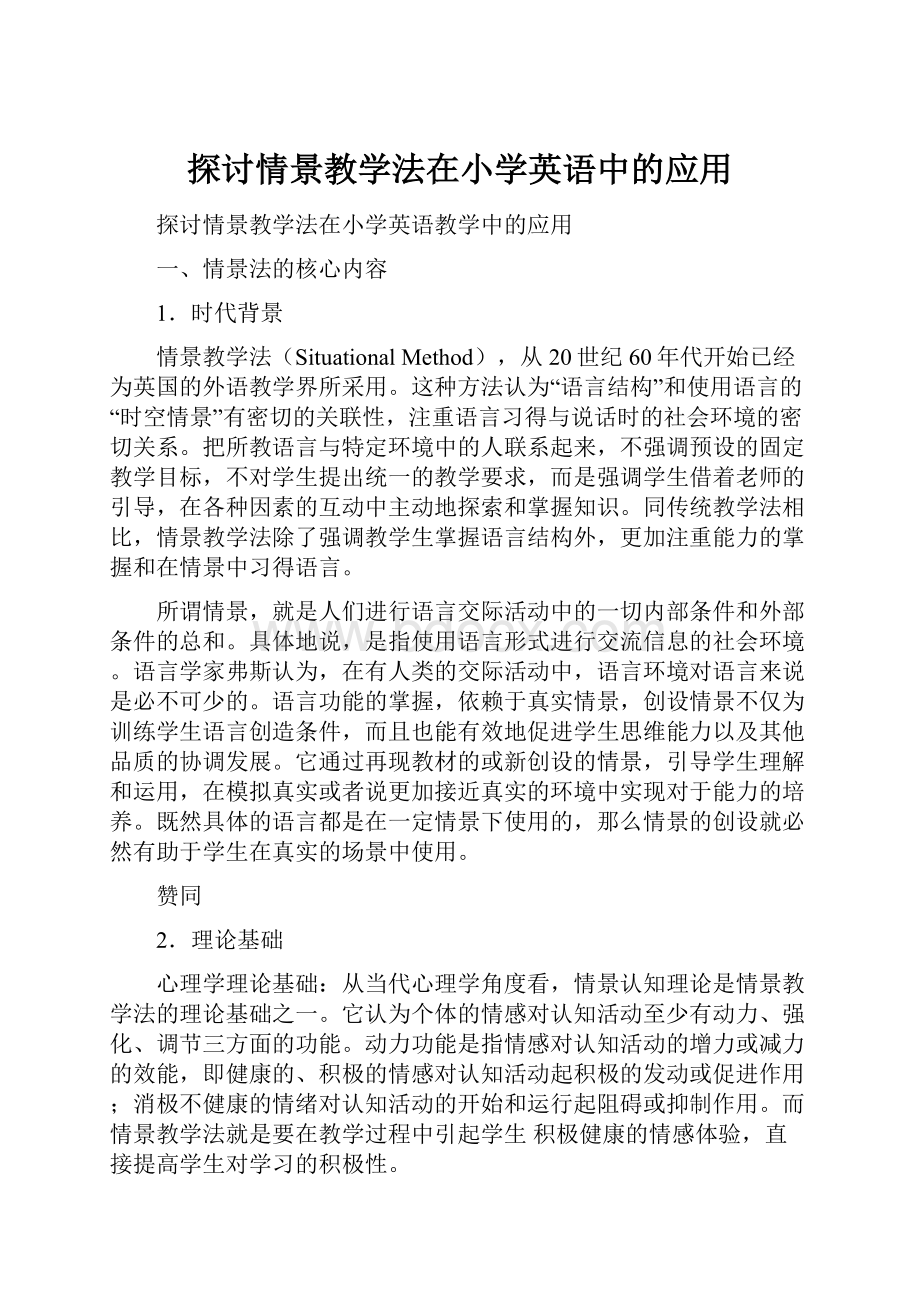探讨情景教学法在小学英语中的应用.docx
《探讨情景教学法在小学英语中的应用.docx》由会员分享,可在线阅读,更多相关《探讨情景教学法在小学英语中的应用.docx(14页珍藏版)》请在冰豆网上搜索。

探讨情景教学法在小学英语中的应用
探讨情景教学法在小学英语教学中的应用
一、情景法的核心内容
1.时代背景
情景教学法(SituationalMethod),从20世纪60年代开始已经为英国的外语教学界所采用。
这种方法认为“语言结构”和使用语言的“时空情景”有密切的关联性,注重语言习得与说话时的社会环境的密切关系。
把所教语言与特定环境中的人联系起来,不强调预设的固定教学目标,不对学生提出统一的教学要求,而是强调学生借着老师的引导,在各种因素的互动中主动地探索和掌握知识。
同传统教学法相比,情景教学法除了强调教学生掌握语言结构外,更加注重能力的掌握和在情景中习得语言。
所谓情景,就是人们进行语言交际活动中的一切内部条件和外部条件的总和。
具体地说,是指使用语言形式进行交流信息的社会环境。
语言学家弗斯认为,在有人类的交际活动中,语言环境对语言来说是必不可少的。
语言功能的掌握,依赖于真实情景,创设情景不仅为训练学生语言创造条件,而且也能有效地促进学生思维能力以及其他品质的协调发展。
它通过再现教材的或新创设的情景,引导学生理解和运用,在模拟真实或者说更加接近真实的环境中实现对于能力的培养。
既然具体的语言都是在一定情景下使用的,那么情景的创设就必然有助于学生在真实的场景中使用。
赞同
2.理论基础
心理学理论基础:
从当代心理学角度看,情景认知理论是情景教学法的理论基础之一。
它认为个体的情感对认知活动至少有动力、强化、调节三方面的功能。
动力功能是指情感对认知活动的增力或减力的效能,即健康的、积极的情感对认知活动起积极的发动或促进作用;消极不健康的情绪对认知活动的开始和运行起阻碍或抑制作用。
而情景教学法就是要在教学过程中引起学生积极健康的情感体验,直接提高学生对学习的积极性。
3.基本特征和优缺点
特点:
语言教学应从口语开始,先听说,后读写;以外语教授外语;以情景方式把新语言点引出;词汇选择以常用为原则。
在教学材料的安排上要按语法结构、句型,由易到难来安排。
优点:
1.消除学生的紧张心理。
情景教学法重视学生的情绪情感生活,集直观性、启发性、形象性、情感性于一体。
情景教学的创设切合学生实际、切合教材内容、切合语言交际的实际,新颖而富于启发性。
教师在课堂上使学生感到和蔼可亲、可信,学生就会消除紧张恐惧心理,踊跃发言,变被动学习主为主动学习,为学好该科奠定了可靠的心理基础。
2.吸引学生的注意力。
“注意”是学生认知客观世界,获取知识,发展智力和培养能力的基础。
而情景教学法就是设法创设各种生动有趣,贴进学生生活的情景、画面,集中学生的注意力,调动他们的积极性,使他们寓乐于学,寓学于乐;学有所乐,学有所得。
3.降低学生的理解难度。
情景中创设的语境是语言赖以生存和发展的环境,也是语言交际所依赖的环境。
语言意义的理解,以及语言功能的实现皆需通过语境。
情景教学法正是要想方设法利用各种手段为学生创设一种学习英语的语言环境。
在相应的语言环境中完成教学内容,降低学生理解语言的难度。
缺点:
1.疏于强调整体结构感知和综合训练,忽视语言知识的分析和讲解,不利于学生学习和运用英语。
在教学过程中教师通过充分巧妙地运用图片、适当用英语分析讲解语言点、用英语提问来提高学生听说读写和应用英语的综合能力。
2.过于重视语言形式,忽视交际能力的培养。
强调以情景为线索来选择和安排语言材料,但由于情景的设计常常是虚构的,因而情景中的话语并不能最大限度地满足学生言语交际的实际需要。
在英语学习过程中,教师通过展示实物、图片、放映幻灯、教学电影,尽可能让学生运用各种感官,去充分感知学习内容,获得最大量的信息,从而加深对学习内容的印象,把课文内容与实际情景、事物联系起来,以帮助学生形成正确的、深刻的概念。
二、教学模式
1.创设—感知
这是小学英语情景教学模式的初始环节,在这一环节中教师通过认真专研教材,设计教学方案,为学生学习创设情景,营造良好的课堂氛围,使学生初步感受新知,并以此激发学生的学习兴趣和求知欲。
2.启发—领悟
这是小学英语情景教学模式的重要环节,在这一环节中教师通过实物、图片多媒体等创设情景,将抽象的单词、句型直观化、形象化,使英语教学自然而然地在一定的情景中进行。
帮助学生理解、记忆所学的新知识,加强英语语言的训练。
3.引导—创设
这是小学英语情景教学模式的中心环节,在这一环节中,教师应确立学生的主体地位,引导学生在感悟的基础上自主创设情景,熟练掌握并运用所学知识,培养合作和交流的意识,提高口语交际能力。
4.链接—迁移
这是小学英语情景教学模式的最后环节,在这一环节中,教师把课堂向社会链接,为学生提供真实的生活情景,将学习场地从教室迁移至室外,培养学生的实践能力,拓宽英语学习界面。
三、教学活动设计
(一)Activityone:
singasongtoteachnewwords
1.Teachingmaterial:
wordsfromnewPEPEnglishforprimaryschoolstudentsbook1unit5aboutcolors.
2.Activityname:
singasongtoteachnewwords.
3.Introduction:
theactivitymainlyaimstohelpthestudentstoreadandrecognizethedifferentcolors;what’smore,bytheendofthelessonstudentscanusethewordstomakeashortdialogue.Theteacherwillfirstletthestudentstowarmupbysingingasongtheyhavelearnedbefore,andthenteachthenewwordsbyteachinganewsongwiththehelpofsomepictures.Therefore,thereissomepicturesdrawwithdifferentcolorclothesusedatthebeginningofthelesson.Atthemiddleofthelesson,teacherwillcheckthenewwordsstudentshavemasteredbylettingthestudentstoreadthecolorofstationeryandcolorthepictures,andteachstudentstolearnandmakedialogue.Attheendofthelesson,teacherorganizesthewholeclasstosingthenewsongtogether.
4.Procedures:
Step1:
warmup(2minutes)
Teacher:
greetingtothestudents.
Students:
greetingtotheteacher.
Teacher:
asksthestudentstogethertosingthesong“Hello!
Howareyou?
”
Students:
tosingthesongwithteacher.
Hello!
Howareyou?
Hello!
Hello!
Hello!
Hello!
Hello!
Hello!
Howareyou?
Hello!
Hello!
Hello!
Hello!
Hello!
Hello!
Howareyou?
I’mfine.I’mfine.Thankyou.Thankyou.I’mfine.
I’mfine.I’mfine.Thankyou.Thankyou.I’mfine.
Step2:
leadin(20minutes)
Teacher:
tellsthestudentsthattheyaregoingtolearnanewsongaboutcolorandsayoutthenameofthesong,thentheteachersingthesongonetimebyherself.
Whoiswearinggreentoday?
Whoiswearinggreentoday?
Greentoday?
Greentoday?
Whoiswearinggreentoday?
Greentoday?
Whilesinging,theteacherwillpresentthefirstpicturedrawwithgreencloth.
Students:
bequietandlistentotheteacher.
Teacher:
teachesthesongsentencebysentencefortwotimes.
Students:
learnthesongfollowingtheteacher.
Teacher:
sticksthepicturetotheblackboard,andwritesdowntheword“green”ontheblackboardandteachesthestudentshowtoreadit.
Students:
readthewordaftertheteacher.
Teacher:
usestheabovewaytoteachotherfivenewwords(red,blue,andyellow,orange,purple).
Step3:
practice(15minutes)
Teacher:
showstherelevantcolorsofrealstationeryobject,andreviewthewords(pencil,pen,bag,sharpener,eraser,andruler)onewordstwotimes.
Students:
readthesixwordsaftertheteacher.
Teacher:
showsanobjecttoaskstudentsayoutthecolorandtheword.Forexample:
whenteachershowsagreenpencil,studentshouldsay‘greenpencil’.
Students:
sayoutthecolorandthewordaccordingtothecolorandobjecttheteachershows.
Teacher:
givesapicturewhichincludingpencil,pen,bag,sharpener,eraser,rulertoeverystudent,andthenaskthestudentstocolorthepictureaccordingtotheirfavor.
Students:
colorthepictureaccordingtotheirfavor.
Teacher:
teachesthestudentstomakeashortdialogue
A:
Ihavearuler.
B:
whatcolorisit?
A:
Guess!
B:
Yellow?
Green?
A:
Yes./No,it’s......
Students:
makeadialoguewiththeirpartneraccordingtotheirrealsituations.
Step4:
(3minutes)
Teacher:
organizethewholeclasstosingthenewsongandchangethekeywordofcolorwhenitnecessary.
(二)Activitytwo:
roleplay
1.Teachingmaterials:
wordsandsentencesfromPEPEnglishforprimaryschoolstudentbook1unit5let’seat.
Words:
chicken,bread,cake,Frenchfries,hamburgers
Sentences:
Whatdoyouliketoeat?
——Iliketoeat...
----Whatabout…?
——Yes,Ilikeitverymuch./No,Idon’tlikeit.CouldIhave…?
----Hereyouare.
----Thankyou.
----Youarewelcome.
2.Activityname:
role-play
3.Introduction:
Inordertoconsolidatethewordsandsentencestructuresthestudentslearnedlastperiod.TheteacherappliesTheSituationalApproachtothisrole-playactivityatthebeginningofthelesson.Inthis25-minuteactivity,somepicturesaboutfoods,chalks,andblackboardwillbeused.Throughthisactivity,theteacherwillknowaboutthestudents'understandingofthewordsandsentencepatterns.Ontheotherhand,it'sagoodchanceforthestudentstopracticeusingthetargetlanguagesmoothly.Furthermore,students’communicativeabilitywillbedeveloped.
4.Teachingprocedures:
Step1:
revision(1minute)
Theteacherwillshowthepicturesaboutfoodswhichtheylearnedlastlessontothestudentsandaskthemtosayoutthewordsonebyone
(Theteacheraskthestudentsquestion:
“what’sthisinEnglish?
’’,pointingatthepictureaboutfoodsontheteacher'shand,guidingthestudentstoansweraccordingtothepicturesontheteacher’shandandsayoutwhichfoodstheylikeortheydon'tlike)
Step2:
before-activity(6minutes)
Theteacherwritesdownthesentencestructurestheylearnedlastlessonontheblackboardandtellthestudentstheywilldoanactivitynamedrole-play
Provideaspecificsituationtothestudents
(Situation:
MaryandLucyandLilyareclassmates.Oneday,theyaregoingtoseeamovie,beforethis,theywanttohavesomefoods;therefore,Lilygoestobuytheticketsandwaitsatthecinema,MaryandLucygototheMacDonaldtobuysomefoods,.)
(3)Theteachertellsthemtherulestodothisactivityandthendividethestudentsintoseveralgroupsoffourmembers.
(Teachermaysay:
“Therearethreemembersineachgroup,oneactsasawaiter,andtheothertwoarecustomers.Youallshouldmakeaconversationaccordingtothesituation,usingthewordsthatwejustreviewandthesentencestructuresontheblackboard.Iwillgiveyou5minutestoprepare”.)
Whenthewholeclassarepreparing,theteachershouldwalkaroundtoprovidehelpifnecessary.
(Possiblesituation:
Somestudentsmayasktheteacherhowhe/shecandescribewhenhe/shewantstoaskLucy"whatdoesLilyliketoeat".Theteacher’spossibleanswer,“YoucansaywhatdoesLilyliketoeat?
)
Step3:
during-activity(approx.13minutes)
Askthestudentswhethertheyhavefinishedthepreparation
Inviteonegrouptoperforminfrontoftheclassasanexample.
(Possibleconversationbetweenfourstudents:
studentA(actasLucy),studentB(actasMary),studentC(actasLily),studentD(actaswaiter),studentA,studentB,studentCandstudentDareabbreviatetoA,B,C,Drespectivelyinthefollowingdescription)
A:
Iamhungry;Iwanttobuysomefoodsfirst.
B:
Ok,let’sgototheMacDonald.
C:
Igotobuytheticket.
D:
WhatcanIdoforyou?
AandB:
Wewanttobuysomefoods.
D:
OK,whatdoyouliketoeat?
’’
A:
Iliketoeathamburgerandchicken.
B:
WhatdoesLilyliketoeat?
A:
Lilylikestoeatbreadandhotdogs,whataboutyou?
B:
Iliketoeatcake.
A:
WhataboutFrenchfries?
B:
No,Idon’tlikeit.CouldIhaveacupofcoke?
D:
sure!
Hamburger,chicken,bread,hotdogs,andacupofcoke.Hereyouare.
AandB:
Thankyou
C:
Youarewelcome.
(3)Askothergroupstogiveperformance
Step4:
after-activity(5minutes)
Theteachermakesconclusionaboutstudents’performanceandthegrammarpoints.
(1)Theteacherprizesstudents’excellentperformance
(2)Guidethestudentstounderstandgrammarpointinitially:
theusageofthethirdpersonalsingular
(Teachermaysay:
“Ok,afteryouracting,canyougetsomepointsthataredifferentfromourlastlesson.”
Students’possibleanswer,wealsousethe“does”and“likes”intheconversation.
Teachermayanswer:
“Yes,soclever,thisisagrammarpoints,thethirdpersonalsingular.
Theteacherexplainsthegrammarpointbylistingmoreexamplesontheblackboard
(Teachermaysays,pleaselookatmoreexamples
Examples:
Sentence1:
Whatdoesyoursisterlikestoeat?
Sentence2:
Mysisterlikestoeatcake.etc.)
Whenwewanttoasksomeoneelsewhichfoodshe/helikes,